Moving with the Migration
Each year, millions of wildebeest and zebra undertake a circular journey around the Serengeti-Mara ecosystem, following seasonal rainfall in the pursuit of green pastures and rewarding grazing. Despite the continuous circular motion, there are two distinct periods of the year when the herds mass together in dramatic fashion, creating mega-herds of hundreds-of-thousands of animals. These two periods are what our migration camps aim to intercept.
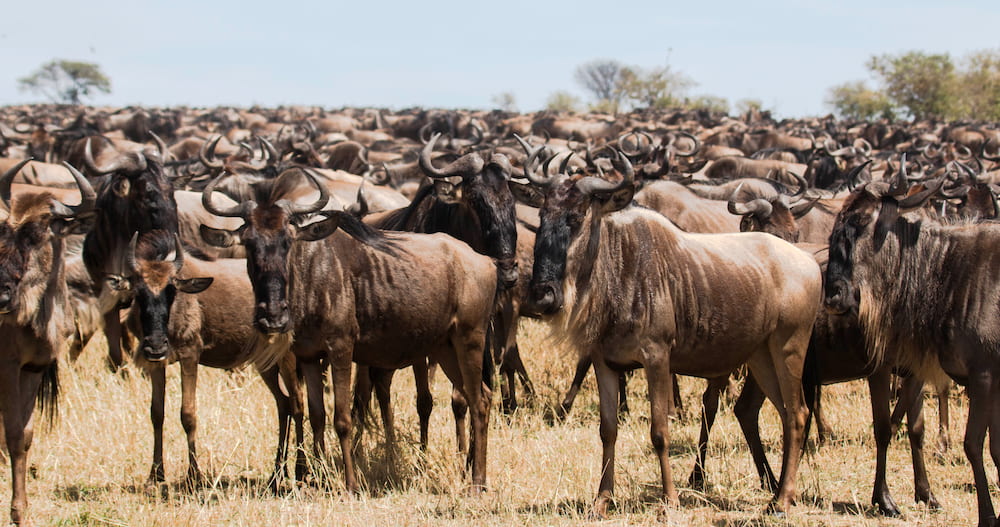
Two million wildebeest annually circumnavigate the Serengeti-Mara ecosystem in an endless battle for survival.
Our migration camps
There are a variety of different types of accommodation structures within the safari space of East Africa, ranging from permanent camps built of stone and concrete, featuring swimming pools, elevated walkways and viewing platforms. At the other end of the spectrum, there is the simplest fly camp consisting of just a small canvas tent, a bag of water strung in a tree for a shower, and basic meals prepared over the campfire. Our migration camps aim to strike a balance somewhere in-between, offering unparalleled game viewing with impeccable service and all the comforts of home. Large, comfortable beds complete with quality linen. En suite bathrooms plumbed with solar heated hot running water. And chefs capable of producing delights that will leave you wondering how such a creation is possible in the middle of the East African bush.
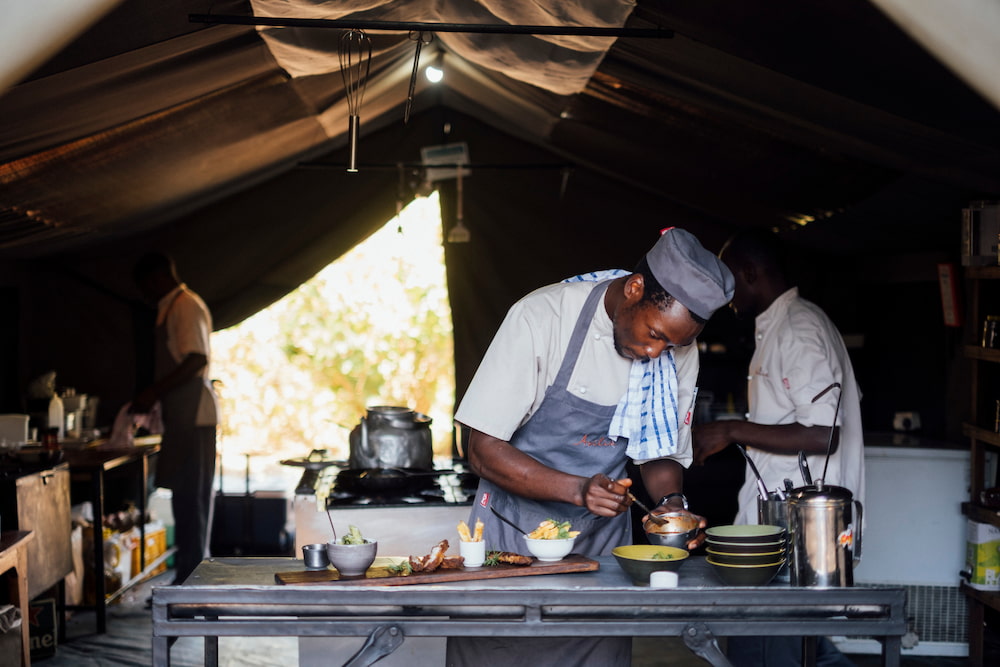
Chef's produce culinary magic from within their simple bush kitchens.
Both Olakira Migration Camp and Ubuntu Migration Camp have been designed in a manner that allows them to be packed up and moved twice a year. Not to be confused with a mobile or fly camp, which can be moved in just a few hours, moving a migration camp takes two to three weeks. Both camps feature spacious guest tents and comfortable lounges in which to relax, but Olakira takes things a step further. Looking to elevate the migratory camp offering beyond the realm of the traditional experience, we introduced wooden decking throughout the tents, and a revolutionary star-gazing extension. Ubuntu, humble in its authenticity, aims to offer a comfortable and affordable under canvas safari experience, in the midst of arguably the greatest wildlife display on the planet. True to their name, both camps change their locations twice a year, migrating from the nutrient rich grasslands of the southern Serengeti to the banks of the Mara River in the northern Serengeti, home to the notorious river crossings.
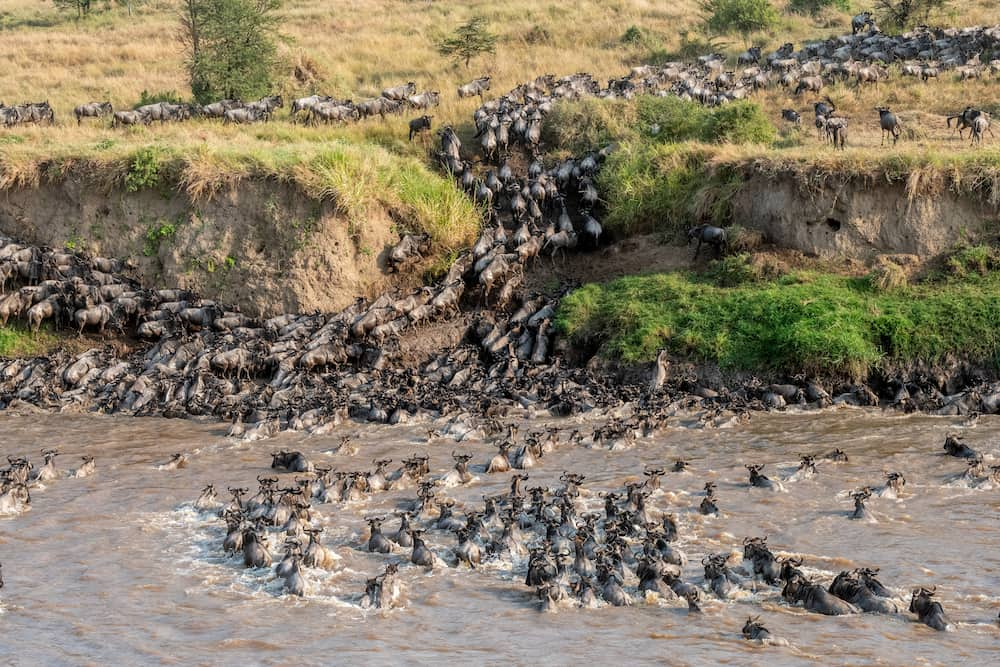
Witnessing the treacherous crossings over the Mara River is on the bucket list for many a safari enthusiast.
The Southern Plains
From December to March, the herds of the Great Migration are usually massed on the short-grass plains of the southern Serengeti. Nourished by fertiliser-like chemicals distributed by erupting volcanoes millions of years ago, these grasslands are still high in nutrients, making it the favoured location for birthing. Over a period of 2 – 3 weeks, approximately 400’000 wildebeest calves are born, creating a frenzy of activity as predators and scavengers compete to pick off the young and old alike. While Ndutu is typically considered the epicentre of the action, with the herds massing out in all directions across the southern Serengeti and the open plains of Ngorongoro, Ubuntu is deliberately positioned on the western flank in Kusini. The location allows for sprawling views over the wildebeest-filled plains, with unrestricted access for game drive action, without being in the very centre of the vehicle and wildebeest induced chaos. In March, the mega-herd begins to break up, as some wildebeest start to move northwards in search of rain fed pastures. Ubuntu closes its doors in mid-March ahead of the rainy season of April and May, using the time for maintenance and the move to the northern Serengeti.
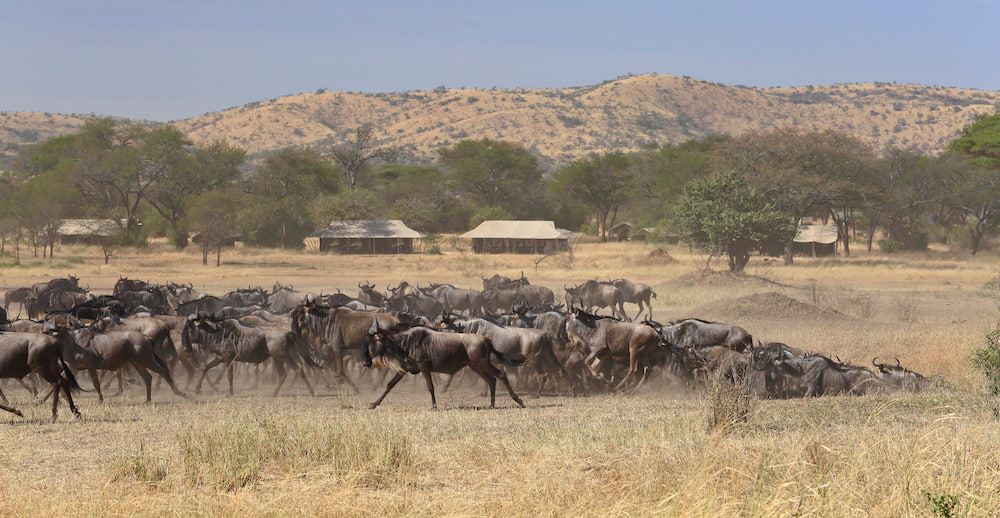
A herd of wildebeest seeking improved grazing on the grasses in front of Ubuntu.
The Lamai Wedge
The Lamai Wedge is a triangular shaped piece of land in the northern Serengeti, bordered by the Kenya-Tanzania border to the north, the Mara River to the south, and the Serengeti National Park perimeter border to the west. With just a low-water bridge across the Mara River, the Lamai Wedge provides an exclusive haven within, what can be, a crowded northern Serengeti. June marks the start of the dry season, and Ubuntu Migration Camp opens its doors in its new location on the Lamai Wedge. The herds of the migration are usually spread out at this time – some making their way up the western flank of the Serengeti, while others venture through the central Serengeti – regrouping on the plains in the north where their numbers swell as the herds reconvene. As their numbers reach capacity in the area, it just takes one leader to start the first river crossing as the lure of greener pastures becomes too hard to resist. The feeding-frenzy in these initial crossings is at its peak as hungry crocodile that have been waiting since November for the return of the herds snatch at everything they can.
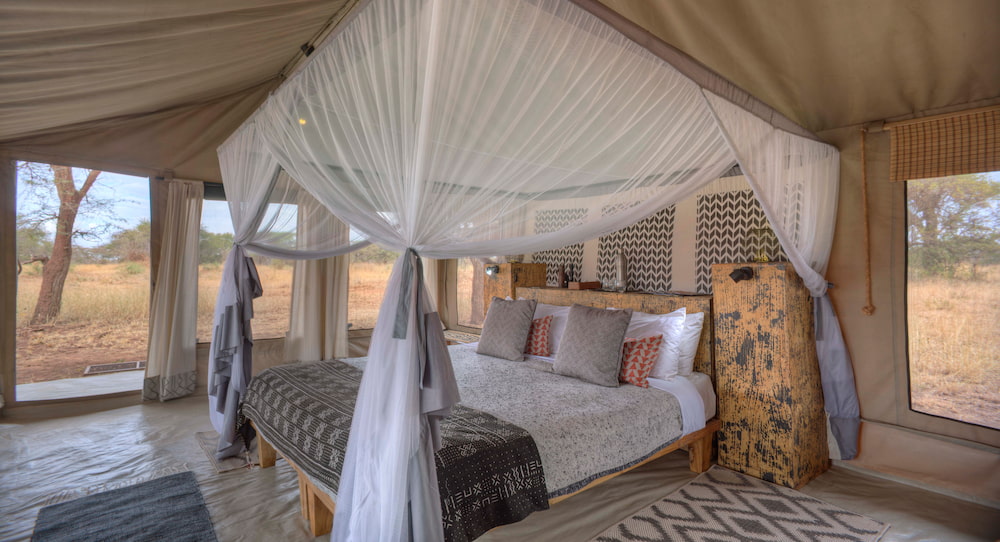
Guest tents at Ubuntu are comfortably furnished, complete with en suite bathrooms and plumbed hot water.
Those wildebeest and zebra that emerge unscathed, find themselves on the Lamai Wedge. With fewer camps and vehicles on the northern bank of the Mara River, the game viewing and river crossing experience is slightly more exclusive. From July until around mid-October, herds of wildebeest will cross back and forth over the Mara River, seemingly in a constant state of confusion as to where they should be, creating nights of being surrounded by grunting and snorting wildebeest. The bulk of the herds cross the border into Kenya’s Masai Mara National Reserve, before turning around to start the return journey back to the southern plains. There are usually still some stragglers in late-October, but by mid-November the northern Serengeti will have returned to a state of calm as its resident game once again take control of their territory. Ubuntu closes its doors, dismantles the camp, and prepares for the move south.
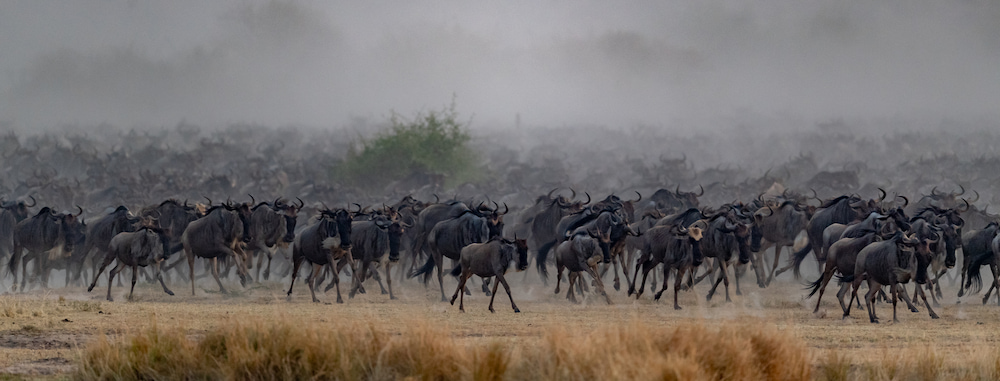
The exclusive Lamai Wedge, between the Mara River and the border with Kenya, is overrun by wildebeest as soon as the river crossings begin.
Ndutu
By early December, the first herds of wildebeest and zebra are usually starting to arrive in the southern Serengeti. Unlike the journey northwards, which can take around 4 months to complete, the southbound leg is often covered in just 6 to 8 weeks. Heavily pregnant females canter onwards driven by the rain and their ingrained knowledge to only give birth in the safety of the southern plains. A wildebeest can delay giving birth, to coordinate with the availability of resources and a perceived strength in numbers. Olakira Migration Camp is primed and ready from the 1st of December, occupying a sought-after location close to the shores of Lake Masek in the Ndutu area, the epicentre of the Migration in its southern months. Each guest tent is situated on an elevated platform with wooden floors, complete with a veranda, enclosed in an insect proof mesh. The bed is on wheels and can be easily rolled across the smooth wooden floor into the enclosed veranda space, allowing for a star-bed experience from within the comfort of your tent. Surrounded by grunting wildebeest at night grazing just metres from your tent, this will be an experience to remember. Game drives venture into the thick of the mega-herd, keeping an eye out for the frequent predator sightings and the action they bring. At the end of March, as the rainy season threatens and the herds begin to move north, Olakira closes for its own migration northwards.
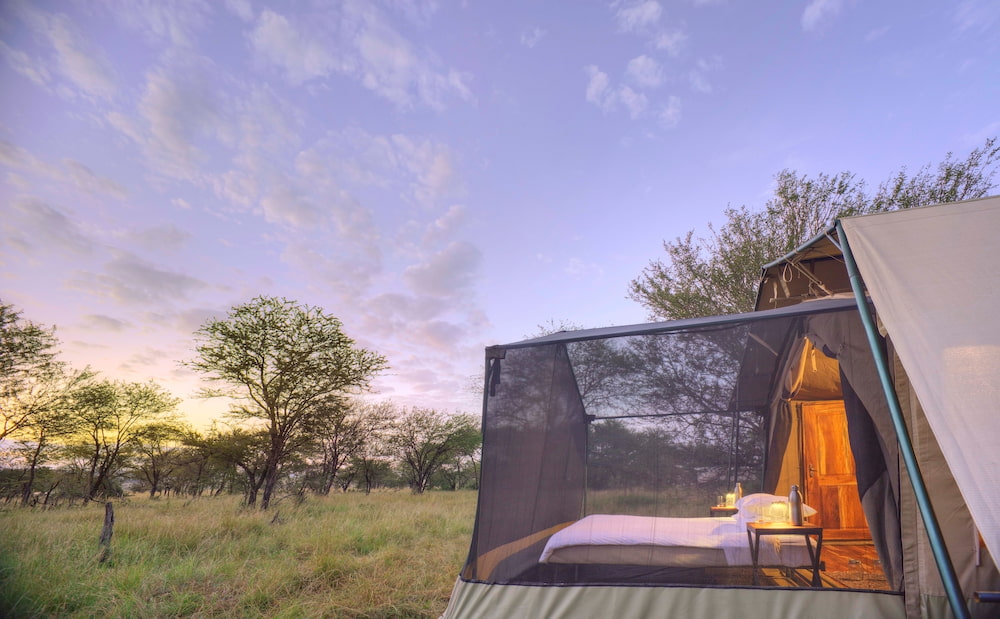
The Olakira star-bed offers a unique sleep out experience, without compromising on comfort.
The Mara River
Over the years, the northern Serengeti has become increasingly busy during the migration season, as more mobile camps open to capitalise on the high tourist numbers flocking into the region with the hopes of witnessing a famous river crossing. At Asilia, we count ourselves amongst the “old guard” of the northern Serengeti, where we have operated migratory camps since 2005, and pioneered the first permanent camp in the area, Sayari, towards the end of 2008. Our experience shows in the location of Olakira. Set slightly back from the Mara River, the camp rests in a secluded location away from busy roads and congested areas, but close enough to be immersed in the herds of wildebeest as they mass in the north, and just a short 20-minute drive to the river. Game drives are spent in amongst the herds, or parked close to the river in anticipation of a river crossing getting underway. Evenings around the fire, under the canopy of stars are accompanied by the snorts of wildebeest. From the darkness of your star-bed, those snorting wildebeest will be just a couple of metres from your feet. At the end of October, Olakira Migration Camp bids farewell to the northern Serengeti, as it starts its journey south.
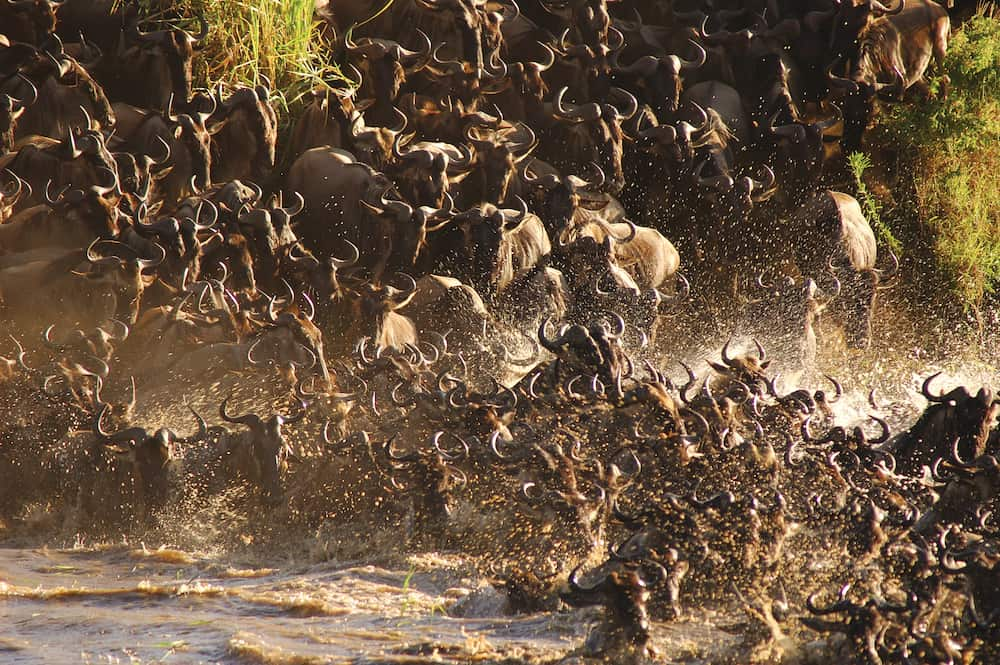
Both Olakira and Ubuntu offer excellent access to the spectacle of chaos that is a Mara River crossing.
What it takes
Both Olakira and Ubuntu consist of 10 en suite guest tents, a lounge, dining tent, and communal bathroom. At the back of house, there is a manager’s office, kitchen, staff accommodation, additional guide tents, and staff dining quarters. Throughout the camp, there are plumbing pipes, internet wiring and electrical cabling running from generators and solar panels to batteries and tents, all buried below ground and out of sight. There are fridges and freezers, stoves and ovens, crockery, cutlery, glasses, couches, beds, water tanks and generators – all of which needs to be packed and secured into trucks for the long journey ahead. It usually takes about five days to completely dismantle a camp and, by the time the trucks are ready to depart, the only signs that a camp was ever there are the flattened areas of grass where the tents previously stood. By the time we return, in six or seven months, the campsite will once again be completely wild.
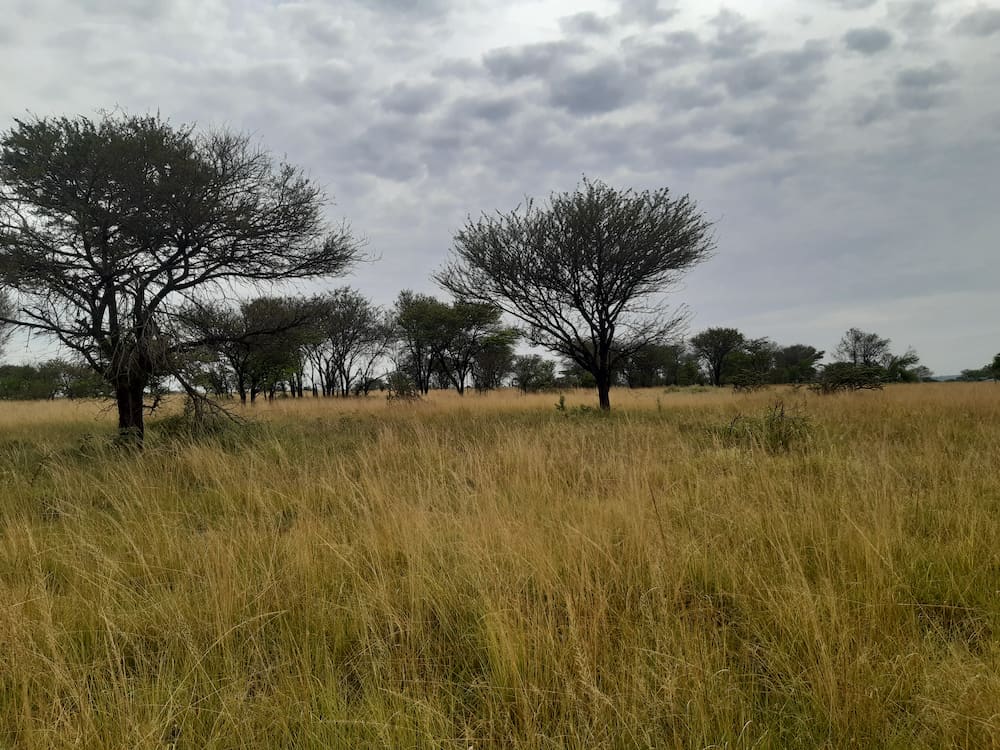
After six months away, a camp site is completely reclaimed by the wild, with no sign of a camp ever having been here.
The onward journey can take a number of days. The move often coincides with wet weather, making the roads difficult to navigate and causing additional delays as the trucks get stuck in the resulting mud. Some nights are spent in a beautiful setting beneath trees, while others are alongside the road and a broken-down truck. Considerable planning needs to go into this process, to ensure that food, water, firewood and sleeping gear are all readily available without having to unpack unnecessary equipment. When the convoy eventually makes it into the new camp location, the hard work begins again. Creating a firebreak is the first, and potentially most important, task to be completed. Staff tents and a staff kitchen are next, then all groundwork is completed – clearing grass, determining the camp layout, unpacking and connecting solar panels, and laying plumbing pipes and electrical cables. Only then is the team ready to start pitching guest tents, placing furniture and ensuring the lounge and dining areas are guest ready.
After roughly three weeks of hard physical work and rough sleeping conditions, the team can relax, explore their new surroundings, and prepare to welcome you into their home.
More Destinations Articles

What’s the difference? National Parks, Game Reserves, and Conservancies in East Africa
02 February 2020To most of us, a national park, game reserve, or conservancy are all the same...

7 Of Our Favourite Things About Lake Manyara National Park
04 December 2019Lake Manyara National Park is located in Tanzania's Arusha and Manyara region...

Naboisho: Home To The Mara’s Newest Pool
28 November 2019Naboisho is now home to the Mara Naboisho Conservancy’s newest pool. During t...

Guest Gallery: The Serengeti At Its Best
27 November 2019We recently had the pleasure of welcoming guests, Chris and Monique Fallows t...





